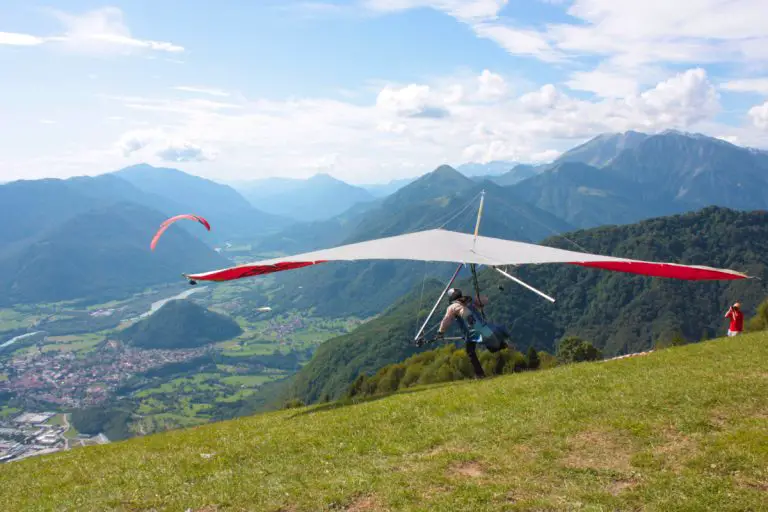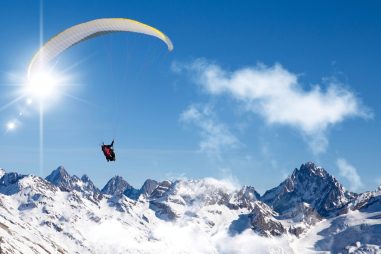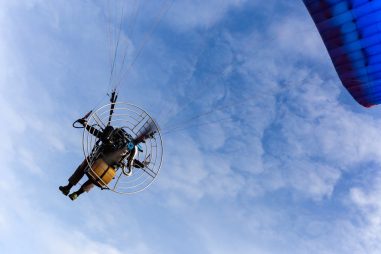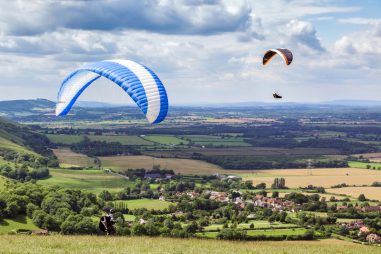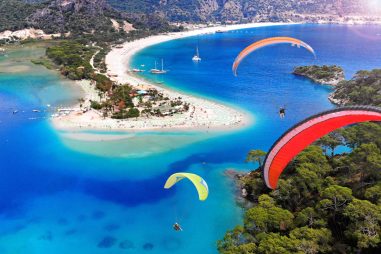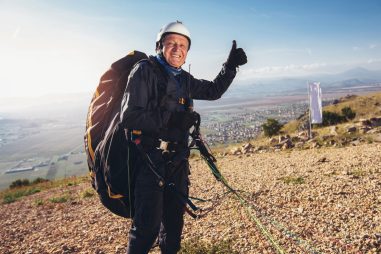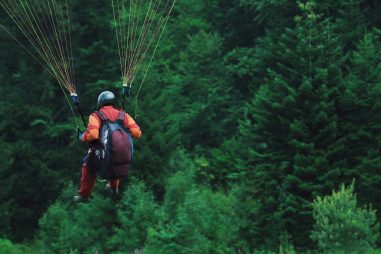If it’s about ease of use, paragliding triumphs over hang gliding. It’s ideal for a pleasant and less intimidating experience for airborne activities. So, if you’re curious if paragliding or hang gliding suits you more, continue reading below.
Is Paragliding and Hang Gliding the Same?
The two aerial sports have numerous similarities but are entirely different. Both are similar in terms of convenience as it is readily available compared to others. In addition, hang gliding and paragliding are motor-free and require being launched from the ground.
Whether you try either, both provide a simple flight experience that does not overly exert the user physically. But do note that you need to wield power to accelerate and propel yourself upwards at the launch.
What Is the Difference Between Hang Gliding and Paragliding?
The difference is mainly the wing shape, position, and speed. Although both air sports seem similar, hang gliding and paragliding have a lot of differences that separate each other. However, the main dissimilarity between the two is ‘control.’
For hang gliders, it’s typically controlled by the pilot. Meanwhile, paragliders rely on air pressure to maintain their shape.
Is Paragliding More Dangerous Than Hang Gliding?
According to recent statistics, paragliding has a higher fatality rate than hang gliding. The mishaps are due to the possibility of paragliders collapsing while in the air. Here are other dangers paragliding could encounter.
- Weather: Paragliders are more prone to wind and turbulence change. This event could cause the user to spin out of control or get blown around in the air.
- Cloud suck: Paragliders are more likely to get in trouble if this natural phenomenon occurs. Due to its rapid expansion over a large area, paragliders will get caught as their maximum speed is less than 30 knots.
- Wing collapsing: Paragliding could quickly lose its wing shape as it simply relies on air pressure.
Meanwhile, although paragliding has more fatality rates, hang gliding is more injury-prone. More specifically, hang gliders are most likely to suffer landing injuries. In addition, since hang gliding has a higher speed than paragliding, there is a higher risk of sprained ankle or knee.
Which Is Easier to Learn – Paragliding or Hang Gliding?
Paragliding is easier to learn than hang gliding due to its more relaxed nature. It takes about (10) ten to (15) fifteen days to learn the sport and eventually paraglide alone. However, the duration could be longer depending on the user’s comfort level.
On the other hand, hang gliding takes (3) three to (6) six months to learn. But, it’s possible to shorten this depending on your capability and determination. For example, if you enroll yourself in a hang-gliding school, it will take approximately (5) five to (10) ten lessons.
Is Hang Gliding or Paragliding More Fun?
Depending on your views on what’s fun, you could either go for hang gliding or paragliding. So, opt for hang gliding if you’re more into the thrill, speed, and aerial tricks. Furthermore, it’s perfect if you prefer physically demanding spots more!
Meanwhile, paragliding is more natural, relaxing, and best for sightseeing. Moreover, it’s compatible with people who enjoy taking things slow and the peacefulness it brings. So In the end, it all depends on your taste which air sport is more fun. However, it won’t hurt to personally try both and check which experience you prefer the best.
Tandem Paragliding vs. Hang Gliding
Tandem paragliding and hang gliding support two people— the passenger and the experienced pilot. Although both allow a tandem activity, the two aerial sport differs in many ways. To get you a better rundown on the disparity between the two sports, you need to know the following:
| Tandem Hang Gliding | Tandem Paragliding | |
| Position | The student wears a strapped harness in the front. Meanwhile, the instructor is at the rear wearing a bag-like harness. | For tandem paragliding, each user is strapped into a seat harness. Like hang gliding, the student will be strapped in front while the instructor takes the rear spot. |
| Wing | The tandem hang glider usually has a larger wing area. In addition, it has a ‘‘tricycle landing gear’ for simple takeoffs and landings. | A tandem paraglider is designed with a larger wing that can carry two people. |
| Cost | $150 to $450 | Around $175 |
Hang Glider vs. Paraglider
A hang glider or paraglider are both unpowered gear designed to carry a single user. Although quite similar, a hang glider and a paraglider have a lot of key distinctions:
- Acquiring Proper Training: Training for hang gliding requires at least ten lessons to control the equipment thoroughly. Meanwhile, you can quickly get the hang of paragliding in a couple of classes.
- Safety: Hang gliding provides a secure feeling to the user due to its sturdy frame and technological advancement. On the other hand, paragliding gives the user an overall pleasant feeling due to its slow pacing. Ironically, paragliding shows a higher fatality rate.
- Speed: Paragliders can reach a speed of 20km per hour (18 fps) at best. If you want speed, it’s best to hang glide, allowing you to reach 100km per hour (91 fps).
- Thrill Factor: As mentioned before, hang gliding is the perfect aerial activity for thrill-seekers. It satisfies the user’s need for speed and thirst for aerial tricks. On the contrary, paragliding is best if you’re more into sightseeing.
What Is the Difference Between a Paraglider and a Hang Glider?
Other than the key distinctions between paragliding and hang gliding, other factors set them apart. See below for a summary of their key differences:
| Hang Gliding | Paragliding | |
| Wing Shape | The wing uses a distinct triangular kite-like shape with a more solid material. | Its wing has a softer structure that sports a cocoon-like look. |
| Position | For hang gliding, the pilot’s position involves lying horizontally below the A-frame. | A paragliding pilot sits upright in a harness that serves as a chair.
This position is less intimidating for beginners and provides a more pleasant experience. |
| Harness | A hang gliding harness attaches to the glider’s ‘center of mass.’ It suspends the user— quickly allowing freedom of movement. | The harness is attached to the paraglide’s wing through the baffled cells. It will enable the user to stand or sit. |
| Maneuvering | Hang gliders use ‘weight shift’ to control and maneuver the direction midair.
So it’s essential to train the proper body position to gain adequate airspeed control and direction. |
Paragliders control their flight by using the lines connected to the wing. By grabbing the lines, the user can steer left or right. |
Hang Gliding vs. Paragliding Pros and Cons
Both flying sports have pros and cons that may affect your views in choosing between the two. In addition, aerial sports are often unpredictable because of the weather, so choose which equipment and sport you are most comfortable with.
- Durability: Hang gliders have thicker materials and could last for years. It gives users the advantage of minimizing UV exposure while in the sky. Meanwhile, paragliders are made of thin nylon, which unfortunately suffers from UV damage rather quickly.
- Landing: Paragliders are more convenient to land due to their slow speed. On the other hand, hang gliding needs a precise timing of landing since it’s flying at a higher speed. Due to this, hang gliding is more accident-prone than paragliding.
- Setup: 10 to 15 minutes is needed when setting up hang gliders. However, a paraglide is easier since it takes up to 2 to 5 minutes.
- Wind Penetration: Hang gliding has excellent wind penetration thanks to its pitch control. Compared to this, paragliders have poor wind penetration and are unsuitable for flying in high winds.
What Advantage Does Paragliding Have Over Hang Gliding?
The first advantage of paragliding is appealing to beginners— it’s easier to learn than hang gliding. Other than its digestible lessons, there are other advantages to paragliding, such as:
- Cost Effective: Paragliders are superior when it comes to being cost-effective since it takes fewer lessons to learn.
- Convenient Storage: Paragliders are suitable for storage. Unlike hang glides with rigid frames, a paraglider folds and can fit in a large backpack.
- Easy Flying Style: It can be launched from a running or a standing jump from any clear surface!
- Weight: You’ll appreciate that paragliders have a constant weight which makes them lighter than a hang glider. This advantage makes it easier for paragliders to fly on a hot day or during light winds.
- Sensation: It provides the user with a calm and relaxed sensation while in the air. So it’s best for users who love to take in the scenery while flying above.
- Avoid Small Injuries: It’s easier to avoid small injuries when paragliding since it does not require any physical effort, unlike hang gliding.
- Flying Spots: Being a paraglider gives you many options for practice spots as more schools are available than hang gliding. So if you want something convenient with various choices, opt for paragliding.
Is Paragliding or Hang Gliding Better?
In weighing the critical features of each aerial sport— it’s safe to say that paragliding can be a better choice. But in the end, if we’re talking about which is the easiest between the two for beginners, paragliding wins by a landslide.
However, if we look at the thrill factor and speed, hang gliding triumphs over paragliding. Especially if you’re the type who wants to eventually learn a few aerobatics tricks in your venture for aerial sports!
Should I Hang Glide or Paraglide?
Ultimately, choosing to hang glide or paraglide is a matter of your preference and level of comfort. Based on the information listed above, many factors must be considered when choosing between the two. If you still can’t decide in the end, experience is the best way to truly figure out which suits you the best.
So why not try paragliding first, as it’s easier to learn. Once you cross that off your list, then try to challenge hang gliding. By the end of the two experiences, you can decide for sure which aerial sport works well for you.

